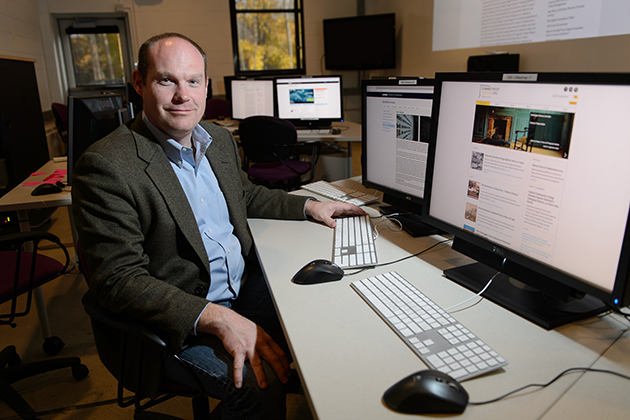
Moving quickly through the halls of Bishop Center, Tom Scheinfeldt passes an “Under Construction” sign here, a blank wall there, and sees nothing but potential.
“This is going to be lab space,” he says, pointing behind a door to a room draped in canvas. “And this is where we’re going to have a space for lunchtime seminars, after-hours meetings, and just a place to show our work.”
It’s fitting that Scheinfeldt looks at an empty room and sees what will soon fill it, since he’s been at the forefront of the discipline of digital humanities since the days when a researcher could count every history-oriented site on the Web.
“It’s less a discipline than a group of people with backgrounds in the humanities applying ourselves to the digital space,” says Scheinfeldt, who joined UConn as an associate professor in the Department of Digital Media and Design this fall.
Scheinfeldt, who holds degrees from Harvard and Oxford universities, came from George Mason University, where he was managing director of the Roy Rosenzweig Center for History and New Media. The center grew from a staff of five when he started to become the world’s largest digital humanities center.
“Right now, I see a similar commitment among the senior faculty and administration at UConn to making the University a leader in the digital space,” says Scheinfeldt, who also serves as director of digital humanities in the Digital Media Center. “The strengths exist already on campus, and if they’re harnessed correctly UConn can be at the front of the field. It’s a real opportunity.”
There’s a mission-oriented aspect to this that I think actually helps us do digital better than private universities … How do we make sure that interactions between scholars and the general public are productive for both?
Part of the opportunity comes from a chance to define what’s understood by the term “digital humanities.”
Scheinfeldt, whose background is in public history and history of science, says the term can mean everything from creating software tailored to the needs of humanities scholars to applying insights about history and culture to digital technology.
“There’s a mission-oriented aspect to this that I think actually helps us do digital better than private universities which don’t have that component,” he says. “How do we serve the public? How do we make sure that interactions between scholars and the general public are productive for both? How does what we do benefit people? Digital humanities is one way UConn can answer those questions.”
To that end, Scheinfeldt has already begun a number of outreach projects aimed not only at benefiting the UConn community on campus, but the state as a whole. He’s working with the Hartford Public Library on ways to tie its extensive programs for new immigrants to its existing collections, and with Connecticut Humanities on ConnecticutHistory.org, what he calls “a re-imagining of what a state encyclopedia looks like in the 21st century.”
He’s also forging collaborations with campus partners, including one with digital archivists and human rights scholars in the Thomas J. Dodd Research Center that would see the creation of a digital volume of the former senator’s papers from his time as executive trial counsel at the famous Nuremberg War Crimes Tribunals.
Those kinds of collaborative efforts are what help set the digital media and design department at UConn apart from counterparts at other schools, which risk becoming too focused on one aspect of digital research or technology, Scheinfeldt says. At the UConn department, which includes artists, programmers, designers, humanities scholars, business experts, and others, cross-fertilizations are a natural part of the environment.
“My prior work always came back to the field of history in one way or another,” he says. “What UConn offers is the opportunity to work across the University: the program we’re starting is radically trans-disciplinary. We’re taking digital media and the digital sphere and we’re bringing it all to the disciplines.”
As the department continues to grow – just like those tantalizingly promising spaces in the Bishop Center – Scheinfeldt says he expects the University’s already burgeoning digital efforts to begin bearing fruit.
“There’s so much activity in the digital realm on this campus,” he says, “and what we can do is provide the focus and resources to get some of these fantastic projects off the ground.”


